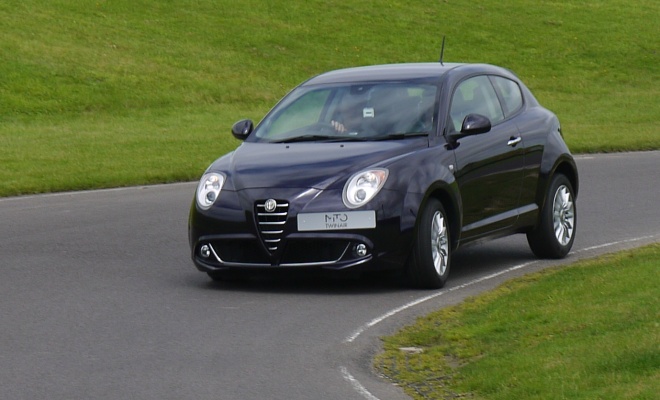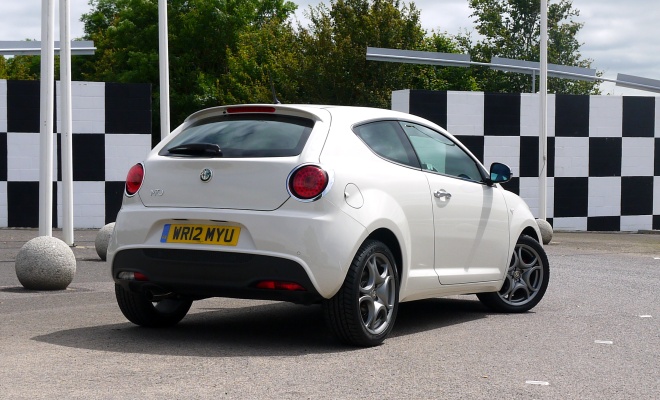
Rating: 3 out of 5 stars
Good: Stylish, with fabulous cabin ambience and a handy sub-100g/km CO2 rating
Bad: Noisy, jittery and not quite as quick as it sounds
Price: from £14,150
Alfa Romeo has chosen to launch the TwinAir edition of its Mito hatchback at the Thruxton kart circuit, which is a kilometre or so of tarmac that feels as if it is entirely composed of corners. You can drive virtually the whole lap in second gear, which is just as well as both arms are needed at all times for spinning the Mito’s largish wheel. Good: Stylish, with fabulous cabin ambience and a handy sub-100g/km CO2 rating
Bad: Noisy, jittery and not quite as quick as it sounds
Price: from £14,150
The circuit is a handy place to explore the different driving modes that can be selected via Alfa’s three-way DNA switch, which first arrived along with the Mito itself back in 2009. Toggle to the middle for the Natural setting, push forward for Dynamic, or pull back and hold for All-weather. Newly added is a memory – the Mito will no longer forget which mode you left it in between journeys, which seems like a sensible improvement.

The differences between the three setups are most marked between Dynamic and the other two, as that’s the only setting to summon all of the engine’s horses. It provides 85bhp at 5,500rpm together with 145Nm of torque from 2,000rpm to 3,500rpm, where the other two modes are capped at 78bhp and 110Nm of torque.
You can feel the difference the moment you switch into Dynamic, with a more responsive throttle action on top of the extra power, together with much firmer steering. The traction control and stability systems also step back a little, letting the tyres squeal in loud complaint around the circuit’s tightest bends. The electronic aids are also looser in the all-weather setting, though the effect is harder to detect with less power available to break traction.

It may be fun slinging a small hatchback around a kart track, but it’s more instructive to head out onto ordinary roads. At the same time we switch from the basic £14,150 Sprint model with its 16-inch wheels, cloth seats and rather ugly vinyl dashboard to the more upmarket Distinctive edition, listing at £15,350 and boasting attractive mock-carbon-weave surfaces up front, 17-inch alloys underneath, plus various other upgrades including rear parking sensors. Finished in a creamy white, it also has £900-worth of optional leather seats.

Running costs should be reasonable enough to tempt buyers who might otherwise opt for used cars. Insurance slots into group 9, tax is zero, the engine has no pricey belts lurking inside, services are 18,000 miles apart, and Alfa is even offering a five-year warranty to retail customers.
The manufacturer expects the TwinAir to become the most popular Mito variant, due largely to its sub-100g/km CO2 rating and promise of 67.3mpg fuel economy.
To have a hope of nearing those figures you will need to wear feather-lined socks or perhaps select Natural mode. The slower setting does rob the car of some of its essential zing, and while it feels fine around town and on the motorway, on A or B roads Dynamic is really a must. The extra muscle means less rowing through the six gears, a more natural feel, and a more satisfying sense of progress.

As with the Punto TwinAir I reviewed recently, the eager little engine is a rowdy and raucous companion, issuing a deep and deceptive thrum that will mislead ears attuned to four-cylinder power. For economy it’s a good idea to change up early, which will mean obeying the rather subtle shift indicator or keeping a wary eye on the tacho until your ears have acclimatised.
The engine feels keen enough, and the 12.5-second sprint to 62mph is not bad for a car powered by just two cylinders and 875cc of capacity.
Ride comfort is another matter. While the Mito has been set up to corner with conviction, over rutted surfaces the trade-off is felt with some uncertain fidgeting and skipping. While the Mito is never as skittish or indeed as airborne as a Mini, it’s not far off. But at least this slightly rubbery feel is leagues better than the roly-poly Punto.

Alfa also makes great claims for engine refinement, with a clever dual-mass flywheel used to dampen the two-pot motor’s natural tendency to shimmy and shake. It works up to a point, but vibration is still abundant if the TwinAir is asked to work hard from low revs, with the gear lever on a occasion wagging like a happy puppy’s tail.
The frameless side windows also seem to generate a fair bit of wind noise at speed, adding a high-pitched sibilance to the engine’s bass-boom beat. A bubble of calm and quiet the Mito TwinAir is not. But on the upside the cabin does offer bags of character, an excellent driving position and superbly supportive seats.

I’ll pass no judgement on the economy available in the real world, because I suspect the TwinAir will be considerably more sensitive to driving style than most of its diesel-fuelled rivals. Keep it set to Natural, obey the shift suggestions and you’ll probably be rewarded at the pumps. But wring out full power, or visit the deceptively close red line, and mpg will no doubt plummet.
If you’re shopping for a refined supermini with outstanding economy, the Mito TwinAir is probably not the car for you. But if you’d like the option of thrift and frugality on some days and the ability to hoon around like a lunatic on others, then this little Mito could be just the car you’ve been waiting for.



